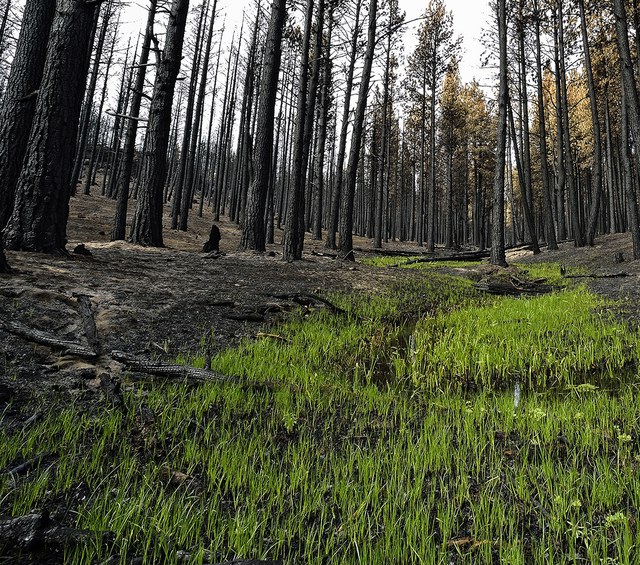The Central Oregon landscape we treasure was born of fire.
Volcanic activity laid the foundation for our area, and frequent fires have long shaped our forests and crafted a fire-adapted way of life east of the Cascades. Indigenous peoples of this region know fire and traditionally used it as a tool to steward these lands. Fire moved herds for hunting, cleared areas for gathering, and improved forest, soil, and grassland health.
As industrialization took hold in the West, people began suppressing wildfires. Instead of living within the historical cycle of frequent, low-severity burns, we worked hard to keep fires from burning for as long as possible. In the absence of fire, our forests grew dense, full of plants competing for limited water and sunlight. For decades, forests continued struggling to grow, building up more and more fuel until fires arrived and consumed these massive fuel stores. Today, fires continue to reliably burn each dry season, ripping through dense understory and crowded canopies that have built up over more than a century of fire suppression.
Pines and other species in Central Oregon’s forest ecosystems have adapted to small, frequent fires but these large, high-severity crown fires can devastate an entire forest ecosystem. Throughout Central Oregon, scorched landscapes exist where tall, fire-adapted pines haven’t been able to withstand these massive burns. As we travel through these landscapes, one can wonder how a forest burnt by fire may ever recover. We know too well that these fires aren’t only dangerous to the organisms living within forests, but also endanger the surrounding communities that rely on and live among these trees.
Researchers find that anthropogenic--or human-caused--climate change amplifies fire activity in the West, and warn that “broadly restoring historical conditions and the historical fire regime is not possible given current landscape conditions and climate change” (Spies et al. 2018). In the West, climate change is warming our atmosphere, which leads to drier fuels in our forests. As wildfires intensify, we experience a harmful feedback loop in which fire activity causes forest mortality, releases carbon emissions, degrades air quality, and warms the atmosphere even more. As the climate becomes warmer and drier, dangerous wildfire conditions persist and expand, repeating this cycle.
Beyond our forests, climate change challenges many other ecosystems and, just like in the forests, it may be too late to return these systems to their former, functional state. Along with fire suppression, communities have taken up many other practices that force us to compete with plants and animals for the natural resources we rely on to survive. Climate change heightens this competition by making these resources increasingly scarce in general. A changing climate is altering the interactions of species and ecosystems at a rate that may leave many behind. Human populations are no exception to this, and as these changes accelerate, so will our need to redefine our interactions with our environment and its resources.
While we can’t know exactly how warming and fire will change our lives here in Central Oregon, your local Land Trust is committed to supporting a landscape that has relied on fire for millennia and supporting a community that is prepared for change.
Learn more:
- Featured Project: Skyline Forest
- Help move our work to combat climate change forward by becoming a member today!


